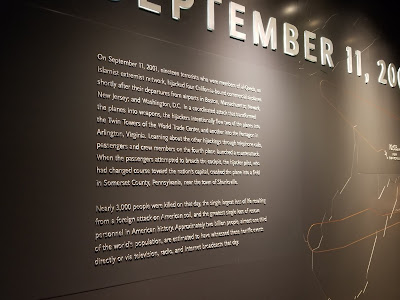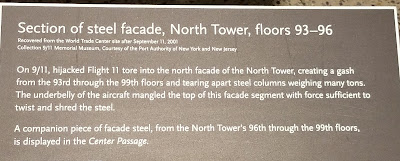#54 New York:
911 Memorial and Museum
Today’s subway ride
went from NJ directly to the World Trade Center. We purchased tickets on line
for this museum too. You not only need the date
of your visit but also the time.
You arrive in the Oculus station. This
building is impressive from several angles. The second shot was taken for the
towers on top of a shorter building in the middle of the photo.
The Oculus
station not only houses the subway lines, but inside the upper two levels you can find a variety of stores.
We arrived early so
we looked at the memorial first. The two
fountains have water falling over each side and into the pool. The names around the North Pool include all
those who lost their life in the disaster.
You cross through a tree filled park to reach the South Pool. The names on the
South Pool include those who died in Flight 192, the Pentagon and Firefighters
and police. The whole memorial is very
impressive.
The Memorial Glade provides an entrance to the park and remembers all those who have died since 911 from injuries sustained in the
disaster. The rocks that line the glade
walkway have metal from the towers in their creation.
The Survivor tree
made an impression on me. It was found
still alive at Ground Zero and rehabbed to survive and live here at the
Memorial!
Our on-line tickets
allowed us to go right into the museum and avoid the long lines waiting to get
in. An escalator takes you down to the Entrance Hall where you start your visit.
The ramp down is an
introduction.
Several pillars display different languages
and are synced with words of people from all over the world giving their
account of September 11, 2001.
Interesting
information! It says what has 200 elevators, 1,200 restrooms, 40,000 doorknobs, 200,000 lighting fixtures, 7 million square feet of acoustical tile ceilings and more structural steel that the Verrazano Narrow Bridge and was build for a final cost of over 1 billion 1970 dollars? The World Trade Center. Every weekday 50,000 people came to work in 12 million square feet of office, hotel and commercial space in seven buildings with 80,000 visitors passing through the enormous interior shopping mall. 10,000 visitors per day would take the express elevator to the 107th floor in 82 seconds to take in the spectacular view. You will need to visit the museum to read the rest.
The ramp allows you
to look down at Foundation Hall that contains remnants of the original World
Trade Center including the slurry wall and the celebrated Last Column.
The slurry wall kept
the Hudson River out of the center.
About 70 feet below street level the foundation for the twin towers was
created.
When the terrorist attacked it was a concern
that the slurry wall might give and allow water from the Hudson River to flood
the area including the subways. The wall
held. It has since been reinforced
again. (I hope you can read some of these reader boards.)
The last column was
just that. It was removed and brought
here to be displayed.
These bent pieces of
steel tell the power of the blast.
Several are erected throughout the museum.
The wall of the
missing where friends and relatives posted pictures of their missing people.
As you descend deeper
down, you pass the actually stairway that allowed many people to get out of the
building. The damage now visible was done during clean up.
Memorial Hall sits
between the two footprints of the Twin Tower.
The footprints are where the girders stood that supported each tower.
I thought this was a rocket. I was wrong. This was an a media antenna from the roof of the North Tower.
These steel girders were curled and mangled from the force of the planes.
As you walk around
the footprint of the North Tower, the story and photos of Stephane Sednaoui
tell the story.
Stephane happened to live near Ground Zero. He heard the planes and ran to the roof where he witnessed and photographed the horrendous events. Over the next few days he volunteered in the rescue efforts underway. He took photos during breaks from digging through the wreckage. After four days he was exhausted. But he did return to do more and work in the Frozen Zone. In emails he acknowledged the emotional toll. With more professionals arriving to help, he concluded his volunteering 5 days after the attack. He captured more than 500 photos on his tiny camera.
Box Column construction was unique to the towers. It hadn't been used in a building of this size.
A Historical
Exhibition of 911 winds around the inside of the footprint. Photography is not allowed. This part is comprised of three parts: the
day of 9/11, what led up to the attacks and the immediate aftermath. I think this is where they had a section on
Al-Quida too.
On the South Tower side they showed various kinds of tributes to the victims of 911.
More steel girders
The South Tower footprint showing other views of the foundation.
In Memoriam, (inside the footprint) section was another no camera zone. Inside this exhibit the faces of all nearly 3000 victims cover the walls. Interactive monitors allow you to bring up a victim’s name and learn about him or her. Or you can search for someone in particular.
This footprint also
includes a movie that shows how the current tower came to be. It also honors all of the rescue dogs that
helped in rescue and recovery.
The gift shop is top
notch and the little café was OK.
Visiting this museum turned out to be a very emotional experience.
I was amazed how it all came flooding back with just a few images. I needed to hurry pass some exhibits: they
memories were too strong. Also for me
the amount of people in a small dark space of the historical exhibits called
for me to go into the light and airy main rooms.
We are glad we
came. The museum and the new World
Trade Tower stands as a powerful and emotional symbol to what happened on
9/11/2001.





















































































No comments:
Post a Comment